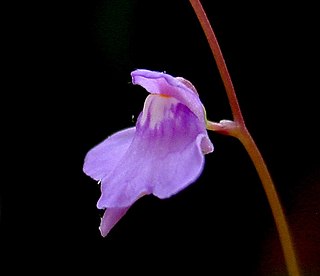
Utricularia amethystina, the Florida purple bladderwort, is a variable species of terrestrial bladderwort native to Bolivia, Brazil, Guyana, Peru, and south-west Florida. The small flowers can be purple, lilac, white, bluish, cream, or bright yellow, and are also highly variable in size and shape.
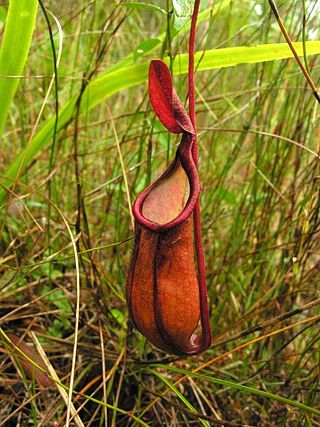
Nepenthes kampotiana is a tropical pitcher plant native to southern Cambodia, eastern Thailand, and at least southern coastal Vietnam. It has an altitudinal distribution of 0–600 m above sea level. The specific epithet kampotiana refers to the Cambodian city of Kampot, close to which the first specimens of this species were collected.
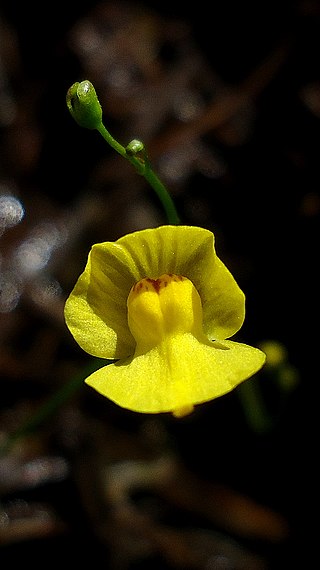
Utricularia gibba, commonly known as the humped bladderwort or floating bladderwort, is a small, mat-forming species of carnivorous aquatic bladderwort. It is found on all continents except Antarctica.

Utricularia pusilla, the tiny bladderwort, is an annual, terrestrial carnivorous plant that belongs to the genus Utricularia. Its distribution includes ranges in Mexico, the Caribbean and Central and South America: specifically in Argentina, Belize, Bolivia, Brazil, Colombia, Costa Rica, Cuba, Dominica, the Dominican Republic, Ecuador, French Guiana, Guatemala, Guyana, Honduras, Jamaica, Nicaragua, Panama, Paraguay, Peru, Puerto Rico, Surinam, Trinidad and Tobago, and Venezuela.
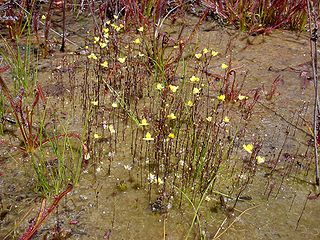
Utricularia subulata, the zigzag bladderwort, is a small annual, terrestrial carnivorous plant that belongs to the genus Utricularia. It is the most widely distributed species in the genus, being almost pantropical.
Utricularia limosa is a terrestrial or subaquatic carnivorous plant that belongs to the genus Utricularia. It is native to Southeast Asia, Australia, China and New Guinea.
This is a list of plants which includes trees and other herbs, vines, climbers, lianas, shrubs, subshrubs that are native or endemic, found in Cuba.

Utricularia intermedia, the flatleaf bladderwort or intermediate bladderwort is a small, perennial carnivorous plant that belongs to the genus Utricularia. It is usually found affixed to the substrate but it can also survive suspended in a body of water. U. intermedia is a circumboreal species and is found in North America, Asia, and Europe.
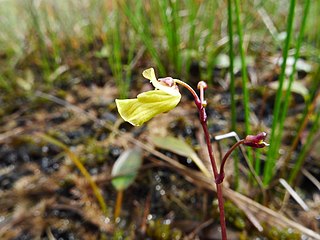
Utricularia ochroleuca, the yellowishwhite bladderwort, pale bladderwort, or cream-flowered bladderwort, is a small, perennial carnivorous plant that belongs to the genus Utricularia. It is usually found affixed to the substrate. U. ochroleuca is a circumboreal species and is found in North America, Asia, and Europe.
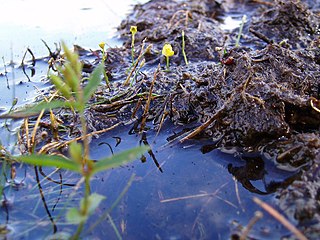
Utricularia olivacea, the piedmont bladderwort, is a very small, annual suspended aquatic carnivorous plant that belongs to the genus Utricularia. Utricularia olivacea is native to Central America, South America, the West Indies, and the eastern United States.
Utricularia punctata is a medium-sized suspended aquatic carnivorous plant that belongs to the genus Utricularia. U. punctata is native to Borneo, Burma, China, Peninsular Malaysia, Sumatra, Thailand, and Vietnam.

Utricularia campbelliana is a small epiphytic, perennial carnivorous plant that belongs to the genus Utricularia. U. campbelliana is endemic to northern South America, where it is found in Guyana and Venezuela and most likely also Brazil, though no positive records exist from that country. It was originally published and described by Daniel Oliver in 1887. It is named in honor of William Hunter Campbell, an attorney and amateur botanist who lived in Georgetown, Guyana. Its habitat is reported as being tree trunks, branches, and prop roots at altitudes from 1,500 metres (4,921 ft) to 2,500 metres (8,202 ft), but has been found at altitudes as low as 690 metres (2,264 ft). It has been seen flowering between August and April. In his 1989 monograph on the genus, Peter Taylor noted that at least one specimen has been recorded as being visited by a hummingbird and it is likely that both U. campbelliana and U. quelchii are bird-pollinated.

Utricularia jamesoniana is a small perennial epiphyte carnivorous plant in the family Lentibulariaceae. It is native to Central America, the Antilles, and northern and western South America. Specifically, it can be found in Bolivia, Brazil, Colombia, Costa Rica, Ecuador, French Guiana, Guatemala, Guyana, Nicaragua, Panama, Peru, Suriname, and Venezuela and on the islands of Guadeloupe, Hispaniola, Dominica, and Martinique. The species was originally published and described by Daniel Oliver in 1860. Its habitat is reported as being mossy tree trunks in montane cloud forests or lowland rain forests at altitudes from sea level to 2,500 m (8,202 ft). It flowers year-round.
Utricularia appendiculata is a medium-sized, probably perennial, terrestrial carnivorous plant that belongs to the genus Utricularia and is the only member of Utricularia sect. Oliveria. U. appendiculata is endemic to Africa, where it can be found in Burundi, Cameroon, the Central African Republic, the Democratic Republic of the Congo, Gabon, Madagascar, Malawi, Mozambique, Tanzania, Uganda, and Zimbabwe. It grows as a terrestrial plant in wet Sphagnum bogs, damp sandy savannas, or in peaty marshes at altitudes from 1,500 m (4,921 ft) to 1,860 m (6,102 ft), but as low as 700 m (2,297 ft) in the Central African Republic. It flowers mostly in the wet season. It was originally published and described by Eileen Adelaide Bruce in 1933 and was placed in its own section, Oliveria, in 1986 by Peter Taylor.
Utricularia cecilii is a small annual carnivorous plant that belongs to the genus Utricularia. It is endemic to an area around Mangalore in Karnataka state and is only known from the type location and one other collection from the same region. U. cecilii grows as a terrestrial plant in damp, shallow soils over laterite. It flowers in August and September. U. cecilii was originally described and published by Peter Taylor in 1984. This species is named in honor of Father Cecil Saldanha S.J., who had shown Taylor this species in 1981.
Utricularia recta is a small, probably annual carnivorous plant that belongs to the genus Utricularia. It is native to Bhutan, China, India, and Nepal. Utricularia recta grows as a terrestrial plant in marshes and bogs from altitudes around 900 m (2,953 ft) to 4,000 m (13,123 ft).

Utricularia striatula is a small carnivorous plant that belongs to the genus Utricularia. It is widespread from tropical Africa to New Guinea. U. striatula grows as a lithophyte or epiphyte on wet rocks or tree trunks at altitudes from near sea level to 3,300 m (10,827 ft). It was originally described by James Edward Smith in 1819.
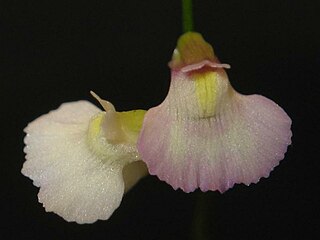
Utricularia rostrata is a small annual carnivorous plant that belongs to the genus Utricularia. U. rostrata is endemic to the Chapada Diamantina highlands of Bahia, Brazil. It grows as a terrestrial plant in damp sandy soils near streams and waterfalls in semi-shaded areas at altitudes from 550 to 1,570 metres. It was originally described and published by Andreas Fleischmann and Fernando Rivadavia in 2009, though specimens of this species had been discovered as early as 1992. Fleischmann and Rivadavia note that the species is common throughout the Chapada Diamantina highlands and its distribution includes Chapada Diamantina National Park, thus justifying its ranking as a species of Least Concern under the IUCN.
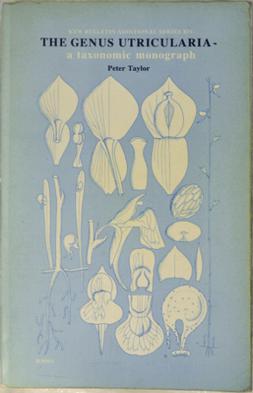
The Genus Utricularia: A Taxonomic Monograph is a monograph by Peter Taylor on the carnivorous plant genus Utricularia, the bladderworts. It was published in 1989 by Her Majesty's Stationery Office (HMSO) as the fourteenth entry in the Kew Bulletin Additional Series. It was reprinted for The Royal Botanic Gardens, Kew in 1994.













